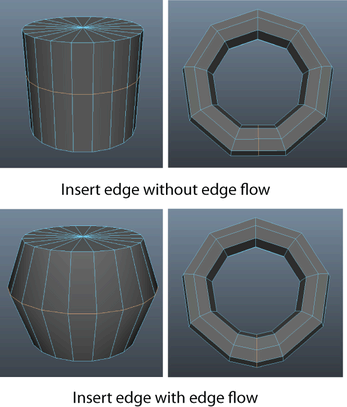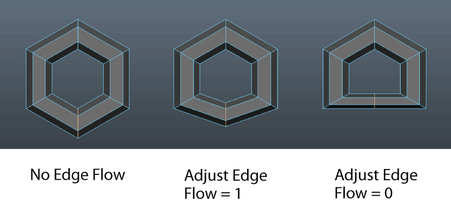In the Modeling menu set, select to open these options. For more information on inserting edge loops, see Insert an edge loop.
- Maintain position
- The Maintain position options specify how new edges are inserted on the polygon mesh.
- Relative distance from edge
-
When the Maintain position is set to Relative distance from edge (default) the dotted insert edge preview locator is positioned along the selected edge based on a percentage distance along the selected edge. For example, if you click and then drag the selected edge to a location that is approximately halfway along the selected edge, the dotted preview locator appears approximately halfway between all of the other edges along the selected edge ring.

- Equal distance from edge
-
When Maintain position is set to Equal distance from edge, the dotted insert edge preview locator is positioned along the selected edges at an absolute distance based on where you click on the first edge. When the length of edges is highly variable, the tool uses the shortest edge to determine the maximum distance the preview locator can be moved. This option is useful if you want the new edges inserted at a specific distance from existing edges. For example, when you want to control any subsequent edge creasing you may perform on the mesh.
Note: The distance the preview locator can move is limited by the length of the shortest edge on the associated edge ring. If the locator quickly snaps to either edge it may indicate a shorter edge in the edge ring that is limiting the placement.
- Multiple edge loops
-
Inserts multiple equally spaced edge loops along the selected edges, based on the number specified in the Number of loops setting. The multiple edge loops cannot be manually repositioned. The maintain distance settings are not available when Multiple edge loops is turned on.
 Note: When the Multiple edge loops option is selected, additional attributes become available on the polySplitRing node that let you modify the 3D profile of the edge loop. For more information see the section "Modifying the 3D profile of an edge loop" below.
Note: When the Multiple edge loops option is selected, additional attributes become available on the polySplitRing node that let you modify the 3D profile of the edge loop. For more information see the section "Modifying the 3D profile of an edge loop" below.
- Use Equal Multiplier
-
See the section "Modifying the 3D profile of an edge loop" below.
- Number of loops
-
Specifies the number of edge loops to be created when the Multiple edge loops setting is on. The default setting is 2. When Number of loops is set to 1, a single edge loop is inserted at the halfway point between the edges.
- Auto complete
-
When Auto complete is on (default), new edges are immediately inserted across the edge ring as soon as you click, drag to position, and then release your mouse button. When Auto complete is turned off, the insert edge preview line remains until you press Enter or right-click and select Complete Tool from the marking menu. Turning Auto complete off is useful when you want to insert edges on a partial edge ring or a multidirectional edge ring path.
Note: When the Auto complete option is turned off you can double-click to select an entire edge ring across a polygon mesh (similar to when using the Select Edge Ring Tool) and then position the insert edge preview locator. Otherwise, double-clicking on an edge when Auto Complete is turned on will immediately insert the edge in a location you may not want. - Fix Quads
-
When Fix Quads is on, three and five-sided regions produced by the inserted edge loop(s) are automatically split to produce regions that are four-sided. This setting is useful when its critical that you maintain the four-sided integrity of the mesh. The default is off.
- Insert with edge flow
-
Lets you insert edge loops that respect the curvature of the surrounding mesh. This option is disabled by default, but you can toggleEdge Flow in the marking menu (Ctrl + Shift + right-click).
Tip: To quickly insert an edge loop with edge flow, temporarily activate Insert with edge flow by holding Shift each time you click an edge where you want a set of new edges to be inserted across the mesh. See Insert an edge loop. Note: This functionality does not support multiple edge loops. When Multiple edge loops is turned on, Insert with edge flow is automatically disabled.
Note: This functionality does not support multiple edge loops. When Multiple edge loops is turned on, Insert with edge flow is automatically disabled. - Adjust Edge Flow
-
Enter a value or adjust the slider to change the shape of the edges before they are inserted.
Set Adjust Edge Flow to 1 to transform the surface curvature of the edges to respect the curvature of the surrounding mesh. At 0 the edges move to the middle of the other nearby edges, creating a flat surface.

- Smoothing angle
-
Specifies whether or not the inserted edges along the edge ring are automatically softened or hardened when the operation is complete. When the Smoothing angle is set to 180 (default) the inserted edges will appear soft. When the Smoothing angle is set to a value less than 180, the inserted edges appear hard.
Modifying the 3D profile of an edge loop
When Multiple edge loops is selected, additional attributes become available on the polySplitRing node that let you modify the profile of the inserted edge loops. This lets you create features that protrude or recess on your polygon meshes along the inserted edge loop.
To modify the cross-sectional profile shape of the inserted edge loop you need to select the polySplitRing node and turn on the Enable Profile Curve. The additional attributes are described below:
Split Ring Attributes
- Divisions
-
Specifies the number of edge loops to be created when the Multiple edge loops setting is on. The default setting is 2. When Divisions is set to 1, a single edge loop is inserted at the halfway point between the edges. This is the same attribute as Number of loops located within the Insert Edge Loop tool settings window.
- Enable profile curve
-
Turns on the profile curve attributes.
- Use Equal Multiplier
-
Relates to the height and shape of the profile curve. When Use Equal Multiplier is off a Selected Value of 1 sets the corresponding vertex offset at a distance equal to the length of the edge being split. When Use Equal Multiplier is on the length of the shortest edge is used to determine the height of the offset.
- Use Face Normals At Ends
-
Specifies that the start and end of inserted edge loop profile protrudes or recedes in a direction that is based on the direction of the face normal instead of the edge normal. The start and end of the edge loop profile expands or contracts in a tapered manner otherwise. This setting is useful when inserting partial edge loops on a mesh.
Profile Curve Options
The following attributes control the appearance of the graph which in turn affects the profile shape of the inserted edge loop.
- Selected Position
-
Specifies the horizontal position of the currently selected graph handle. The Selected Position settings range is between 0 and 1.
- Selected Value
-
Specifies the vertical position of the currently selected graph handle. The Selected Value settings range is between 0 and 1.
When using the default Profile Curve settings, a Selected Value of 1 sets the corresponding vertex offset at a distance equal to the length of the selected edge.
- Interpolation
- Controls the appearance of the profile curve as it passes through the position markers. More specifically, when it leaves one position marker and enters the next.
- None
-
There is no interpolation between position marker values.
- Linear
-
The profile curve exits the selected position marker and enters the next with no smoothing.
- Smooth
-
The profile curve is interpolated through the position marker using a bell curve, then blends the curve to the next position marker.
- Spline
-
The profile curve is interpolated through the position marker with a spline curve, using the tangent values from neighboring position markers to produce a smooth transition.
- Input Scale
-
A multiplier value that affects the vertical range of the profile curve. The default setting is one. When the Input Scale is set to any value other than one, the profile curve’s height is affected based on the following equation:
Length of selected edge X Selected Value X Input Scale + Offset
- Input Offset
-
Specifies an offset value from which the profile curve is based. The default setting is 0 (no offset). You can set the offset using either positive or negative values. The Profile Curve default settings do not easily let you create receding profiles, so the Input Offset is useful in those situations.
